Key Takeaways
- Strategic location selection is crucial – Position your home office away from high-traffic areas with access to natural light, strong Wi-Fi, and adequate power outlets, whilst avoiding bedrooms to maintain work-life boundaries.
- Maximise small spaces with multi-functional solutions – Transform alcoves, under-stair areas, or spare room corners using built-in desks, wall-mounted storage, and fold-away furniture to create productive workspaces without requiring extensive renovation.
- Colour psychology directly impacts productivity – Use muted blues and greens for sustained concentration, soft neutrals to reduce visual distractions, and strategic yellow accents to boost creativity whilst maintaining professional appeal.
- Layer lighting for optimal functionality – Combine task, ambient, and accent lighting with LED solutions positioned at 45-degree angles to your workspace, utilising natural light perpendicular to windows to reduce eye strain and energy costs.
- Invest in ergonomic furniture for long-term comfort – Choose adjustable desks and supportive seating with proper lumbar support, armrests, and breathable materials to prevent musculoskeletal strain during extended work sessions.
- Implement effective cable management and soundproofing – Use cable trays, grommets, and wireless solutions to maintain organised aesthetics, whilst incorporating soft furnishings, acoustic panels, and strategic furniture placement to create focused, distraction-free environments.
Picture this: you’re staring at that cramped corner of your living room, wondering how on earth you’ll transform it into a workspace that doesn’t make you want to crawl back to bed. You’re not alone – with more households juggling multiple remote workers, creating functional home offices has become less luxury and more necessity.
The good news? To design an office, it doesn’t require a complete renovation or designer budget. According to interior experts, it’s about crafting a space that promotes both visual appeal and wellbeing – a balanced environment where you can actually get things done without feeling like you’re working from a storage cupboard.
Whether you’re carving out space under the stairs or converting an entire spare room, the right design approach can transform even the tiniest nook into a productivity powerhouse. From clever storage solutions to colour schemes that boost focus, these ideas will help you create a workspace that works as hard as you do.
Essential Elements of a Productive Home Office
Creating a productive home office starts with selecting the right location and planning your space effectively. These fundamental decisions impact your daily comfort and work performance.
Choosing the Right Location
Position your desk away from high-traffic areas to maintain concentration throughout your workday. Productivity experts recommend selecting a spot with natural light whilst avoiding direct sunlight on your computer screen.
Consider these location factors when setting up your workspace:
- Noise levels: Choose quiet areas away from kitchen activity and television sounds
- Internet connectivity: Ensure strong Wi-Fi signal strength in your selected area
- Privacy requirements: Select spaces where family members won’t frequently interrupt
- Temperature control: Pick locations with consistent heating and cooling access
- Electrical access: Position near multiple power outlets for equipment and lighting
Corner spaces often provide excellent home office locations as they offer two walls for storage and create natural boundaries. Window-adjacent areas boost mood and energy levels through natural light exposure whilst reducing eye strain from artificial lighting.
Avoid placing your workspace in bedrooms if possible, as this can blur work-life boundaries and impact sleep quality. Guest rooms or converted alcoves typically offer better separation between professional and personal spaces.
Space Requirements and Layout Planning
An 8×10 feet area provides adequate space for a built-in desk and storage solutions, whilst 10×13 feet accommodates a floating desk with additional cabinetry. But, you can create functional workspaces in much smaller areas through smart planning.
Essential space allocation includes:
| Area Type | Minimum Dimensions | Recommended Use |
|---|---|---|
| Desk space | 120cm x 60cm | Computer, documents, writing |
| Chair clearance | 90cm behind desk | Movement and comfort |
| Storage zone | 30cm depth | Files, supplies, books |
| Walking space | 75cm wide | Access and circulation |
Multi-functional furniture maximises small spaces effectively. Consider desks with built-in drawers, ottoman storage seats, and wall-mounted shelving systems. These solutions provide necessary storage without consuming valuable floor space.
Plan your layout with workflow efficiency in mind. Position frequently used items within arm’s reach of your primary seating position. Create designated zones for different activities – computer work, paper filing, and reference materials.
Symmetrical layouts work particularly well for shared home offices. Built-in desk solutions can accommodate two workers whilst maintaining individual storage spaces and reducing workspace conflicts.
Vertical storage solutions maximise limited floor space through wall-mounted cabinets and floating shelves. This approach keeps essential supplies accessible whilst maintaining clean desk surfaces that promote focus and productivity.
Design Styles for Your Home Office
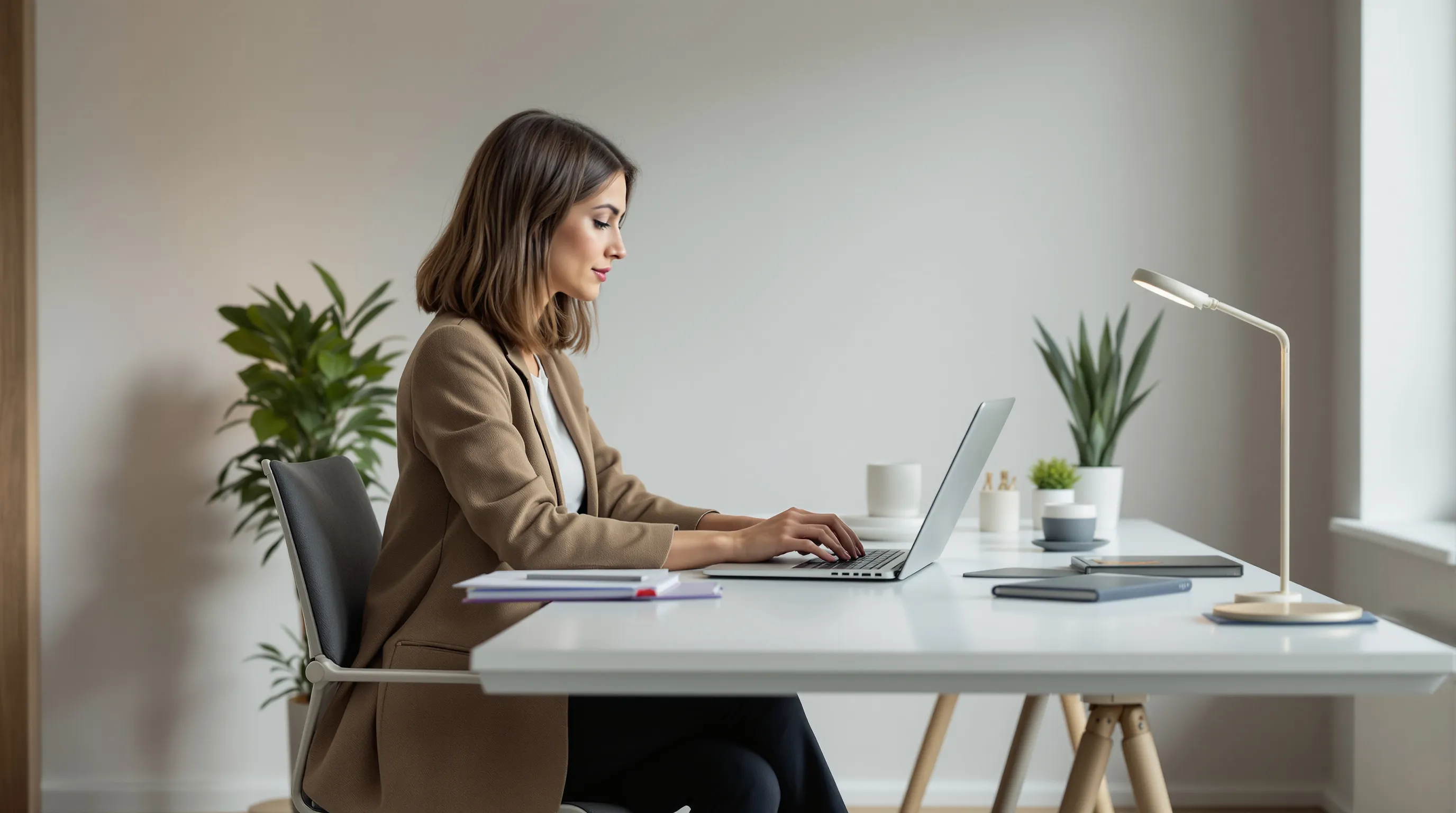
Choosing the right design style transforms your workspace from a functional necessity into an inspiring environment that reflects your personality and work preferences. Three distinct approaches offer different benefits for productivity and comfort.
Modern and Minimalist Approaches
Modern minimalist offices prioritise clean lines and functional simplicity to reduce visual distractions. You’ll want to focus on neutral colour palettes featuring whites, greys and natural wood tones that create a calm atmosphere for concentration.
Smart storage solutions hide clutter behind sleek cabinet doors or within built-in units. Choose furniture with multiple purposes – desks with integrated drawers, floating shelves that maximise wall space, and cable management systems that keep technology organised. A simple white desk paired with just your laptop, a single plant and a quality task lamp creates the perfect foundation.
Ergonomic considerations remain essential in minimalist spaces. Adjustable standing desks, supportive task chairs and proper lighting equipment enhance both comfort and aesthetics. The key lies in selecting fewer, higher-quality pieces rather than filling the space with multiple items.
This style works particularly well if you’re easily distracted, as the uncluttered environment promotes focus. Display only essential items – perhaps 3-5 carefully chosen books, a piece of artwork or a small sculptural object – to maintain visual balance without overwhelming the space.
Traditional and Classic Designs
Traditional home offices embrace timeless elegance through rich materials and sophisticated details. Wood furniture in mahogany, oak or walnut creates warmth and gravitas, while leather seating adds comfort and professional appeal.
Layer different lighting sources to achieve the perfect ambiance. A quality desk lamp provides task lighting, whilst ambient ceiling fixtures or table lamps create a welcoming atmosphere. Consider installing dimmer switches to adjust brightness throughout the day.
Built-in bookcases or display cabinets showcase your professional achievements, book collections or personal items. Panelled walls or detailed mouldings add architectural interest, whilst heavy curtains or quality blinds provide privacy and sound absorption.
Choose seating that balances comfort with style – a leather executive chair for your desk and perhaps a fabric armchair in a reading corner. Rich colours like deep blues, forest greens or burgundy create a sophisticated backdrop, whilst brass hardware and traditional accessories complete the look.
This style suits professionals who appreciate craftsmanship and want their workspace to convey authority and established success. The substantial furniture and quality materials create a sense of permanence and importance.
Bohemian and Creative Spaces
Bohemian offices celebrate creativity through eclectic mixing of colours, patterns and textures. Layer different textiles – think patterned rugs, colourful cushions and textured wall hangings – to create visual interest and comfort.
Incorporate vintage and handmade pieces like rattan furniture, macramé plant holders or antique storage boxes. Mix modern technology with artistic elements – your sleek laptop might sit on a reclaimed wood desk surrounded by handcrafted pottery and vintage books.
Plants play a crucial role in bohemian spaces. Create a mini jungle with hanging planters, floor-standing specimens and desk-top succulents. The natural elements soften hard edges whilst improving air quality and mood.
Express your personality through bold artwork, photographs and collections. Gallery walls featuring mixed frames and subjects create focal points, whilst open shelving displays treasured objects and inspiration materials. Don’t shy away from pattern mixing – combine geometric prints with florals or ethnic motifs for authentic bohemian flair.
This relaxed style reduces work-related stress whilst encouraging creative thinking. The warm, personal atmosphere makes long working hours more pleasant and can boost innovative problem-solving through visual stimulation.
Colour Schemes That Enhance Productivity
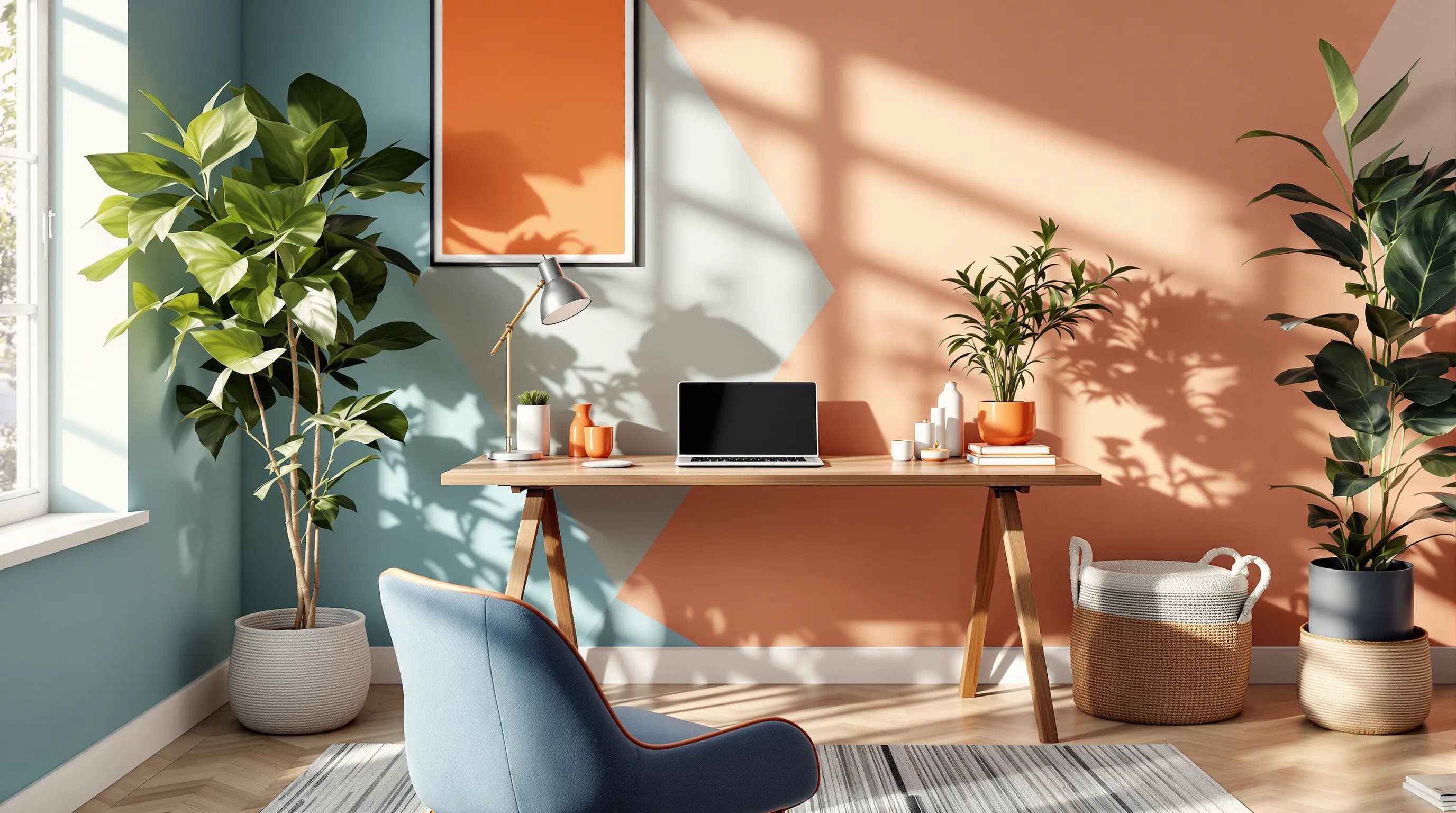
Colour schemes transform your home office into a productivity powerhouse by influencing your mood, focus, and energy levels throughout the workday. You’ll find that specific colours trigger different psychological responses, making your colour choices as important as your furniture selection.
Muted blues and greens create the ideal foundation for sustained concentration. Sophisticated shades like Hague Blue or Pigeon Green provide a calming atmosphere that supports deep focus without feeling cold or sterile. These colours reduce stress hormones while promoting wellbeing, making them perfect for analytical tasks and long working sessions.
Soft neutrals offer versatility for any work style. Beige, light grey, and off-white create a clean backdrop that prevents visual distractions. You’ll notice improved clarity of thought when surrounded by these unobtrusive tones, as they allow your mind to focus on tasks rather than competing visual elements.
Earthy terracotta and burnt orange bring warmth to your workspace whilst maintaining productivity levels. These grounded tones create an inviting atmosphere that prevents the sterile feeling common in traditional offices. You’ll experience comfort and focus simultaneously, making these colours excellent for client-facing video calls.
Pale yellow and cream work exceptionally well in smaller spaces. These light-reflecting colours make compact areas appear more spacious whilst uplifting your mood. Yellow stimulates creativity and innovation, making it particularly suitable for brainstorming sessions and collaborative work.
Strategic Colour Application
| Colour Family | Productivity Benefit | Best Used For |
|---|---|---|
| Blues | Stress reduction, enhanced wellbeing | Analytical work, long sessions |
| Greens | Balanced focus, eye comfort | General office tasks |
| Neutrals | Clarity, distraction reduction | Detailed work, reading |
| Warm earth tones | Comfort, approachability | Client meetings, creative work |
| Light yellows | Creativity, space enhancement | Brainstorming, small offices |
Blue dominates workplace design because it promotes efficiency and reduces anxiety. But, avoid overly dark or cold blues that might feel oppressive. You’ll want blues that feel fresh and energising rather than sombre.
Yellow enhances creative thinking and appears frequently in innovation labs. Use yellow sparingly as accent walls or accessories to prevent eye strain whilst capturing its mood-boosting benefits. You can incorporate yellow through artwork, desk accessories, or a single feature wall.
Balanced colour combinations deliver the strongest productivity results. Pairing yellow’s creative energy with blue’s calming influence creates visual interest whilst supporting both focused work and innovative thinking. This harmony prevents monotony whilst maintaining professional appeal.
Your colour choices should reflect your work type and personal energy needs. Creative professionals might thrive with bolder accents, while analytical work benefits from more subdued palettes. Consider how different colours affect your energy levels at various times of day.
Natural light significantly impacts how colours appear and feel in your space. Test colour samples at different times to ensure they maintain their intended effect throughout your working hours. You’ll want colours that remain pleasant and productive under both natural and artificial lighting conditions.
Furniture Selection and Arrangement
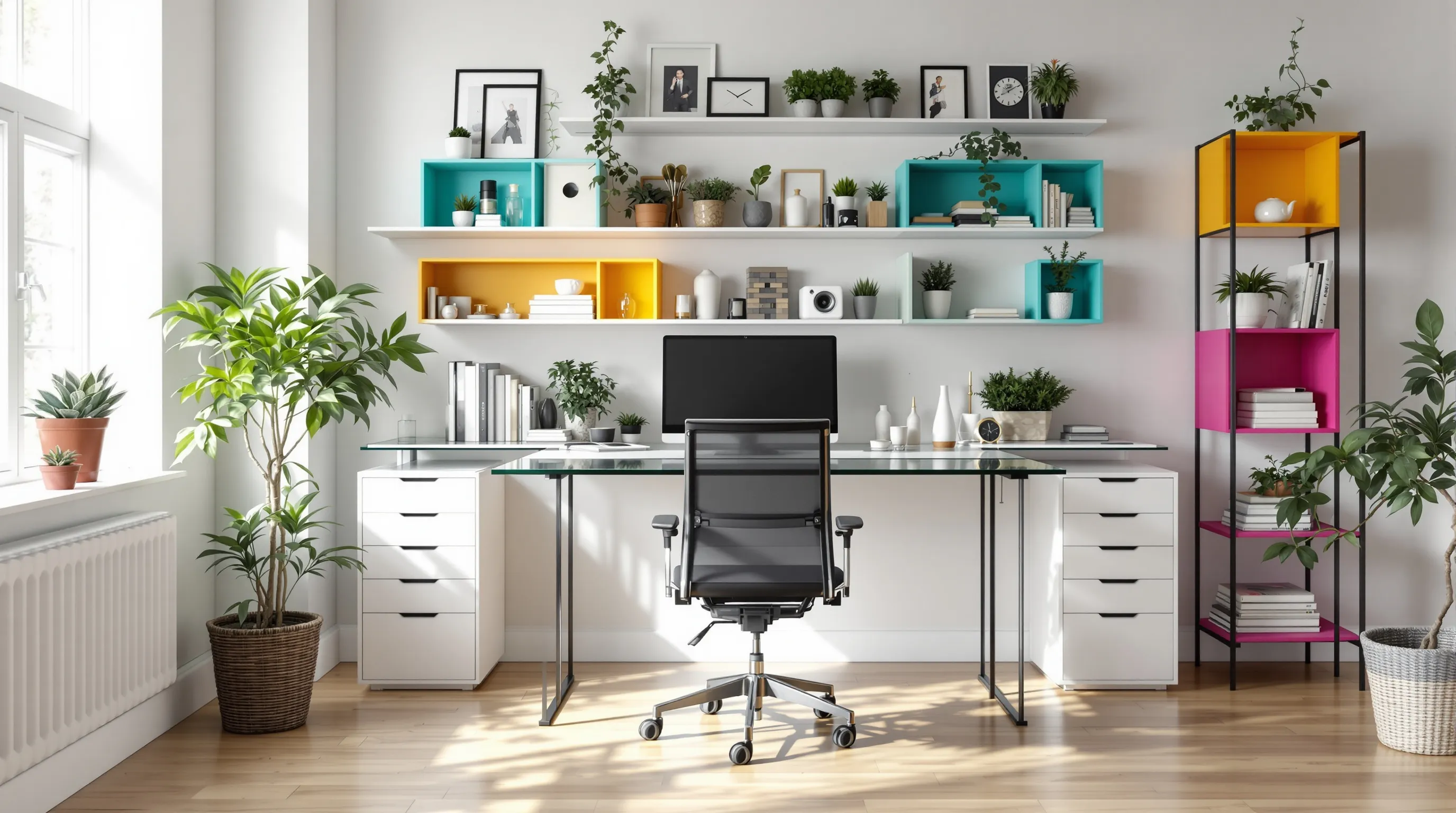
Choosing the right furniture transforms any space into a productive home office environment. Your furniture selection directly impacts both your work efficiency and physical comfort throughout the day.
Desks and Work Surfaces
Your desk serves as the foundation of your home office productivity. Consider your work requirements when selecting a surface that accommodates laptops, monitors, documents, and essential supplies comfortably.
Size and Proportion Considerations
Measure your available space before purchasing to ensure proper fit and movement around the desk. Standard desk heights range from 28-30 inches, but adjustable options provide flexibility for different users. Allow at least 24 inches of depth for computer work and 36 inches of width for basic tasks.
Material Selection Impact
Different desk materials create distinct aesthetic tones in your office space. Glass surfaces offer modern minimalism but require frequent cleaning and show fingerprints easily. Traditional teak provides warmth and durability whilst mahogany adds luxury appeal to professional settings. Pine offers affordability without sacrificing functionality, and bamboo provides sustainable eco-friendly options.
Innovative Design Solutions
Adjustable hexagon desks provide visual interest whilst allowing easy reconfiguration for collaboration or solo work sessions. Console-style desks with integrated storage drawers balance functionality with room aesthetics, particularly effective in smaller spaces. Standing desk converters transform existing surfaces into ergonomic workstations without replacing entire furniture pieces.
Ergonomic Seating Solutions
Your office chair significantly affects your health and productivity during extended work periods. Investing in proper seating prevents musculoskeletal strain and maintains focus throughout the day.
Essential Ergonomic Features
Look for chairs with adjustable seat height to keep feet flat on the floor and thighs parallel to the ground. Lumbar support maintains natural spine curvature whilst adjustable armrests reduce shoulder tension. Back angle adjustment allows you to recline slightly, reducing pressure on spinal discs during long work sessions.
Material and Construction Benefits
Breathable mesh fabrics enhance air circulation, preventing discomfort from heat buildup during extended sitting. Quality foam padding maintains shape over time whilst providing adequate support. Sturdy five-point bases with smooth-rolling casters enable easy movement without floor damage.
Multi-Functional Seating Options
Consider incorporating additional seating beyond your primary desk chair. Comfortable accent chairs provide alternative work positions for reading or phone calls. Ergonomic stools work effectively in compact spaces or standing desk setups, offering support without requiring extensive floor space.
Storage Solutions and Organisation
Efficient storage systems reduce visual clutter whilst keeping essential items easily accessible. Your organisation approach directly influences focus levels and work efficiency throughout the day.
Vertical Storage Maximisation
Wall-mounted shelving utilises vertical space without consuming valuable floor area. Modular shelving systems adapt to changing storage needs whilst maintaining visual cohesion. Floating shelves create storage without visual weight, particularly beneficial in smaller office spaces.
Filing and Document Management
Filing cabinets provide secure document storage whilst serving as additional work surfaces. Mobile pedestals fit under desks to maximise space efficiency. Document organisers and desktop filing systems keep frequently accessed papers within arm’s reach.
Hidden Storage Integration
Desks with built-in drawers conceal office supplies whilst maintaining clean aesthetics. Ottoman storage provides dual functionality as seating and storage containers. Under-desk cable management systems hide technical equipment whilst maintaining easy access for maintenance.
Display and Personal Storage
Display cabinets with integrated lighting showcase professional achievements whilst protecting items from dust accumulation. Bookcases transform office spaces into personal libraries, combining professional storage with intellectual atmosphere. Personalised storage solutions reflect individual style whilst maintaining professional appearance standards.
Small Space Home Office Solutions
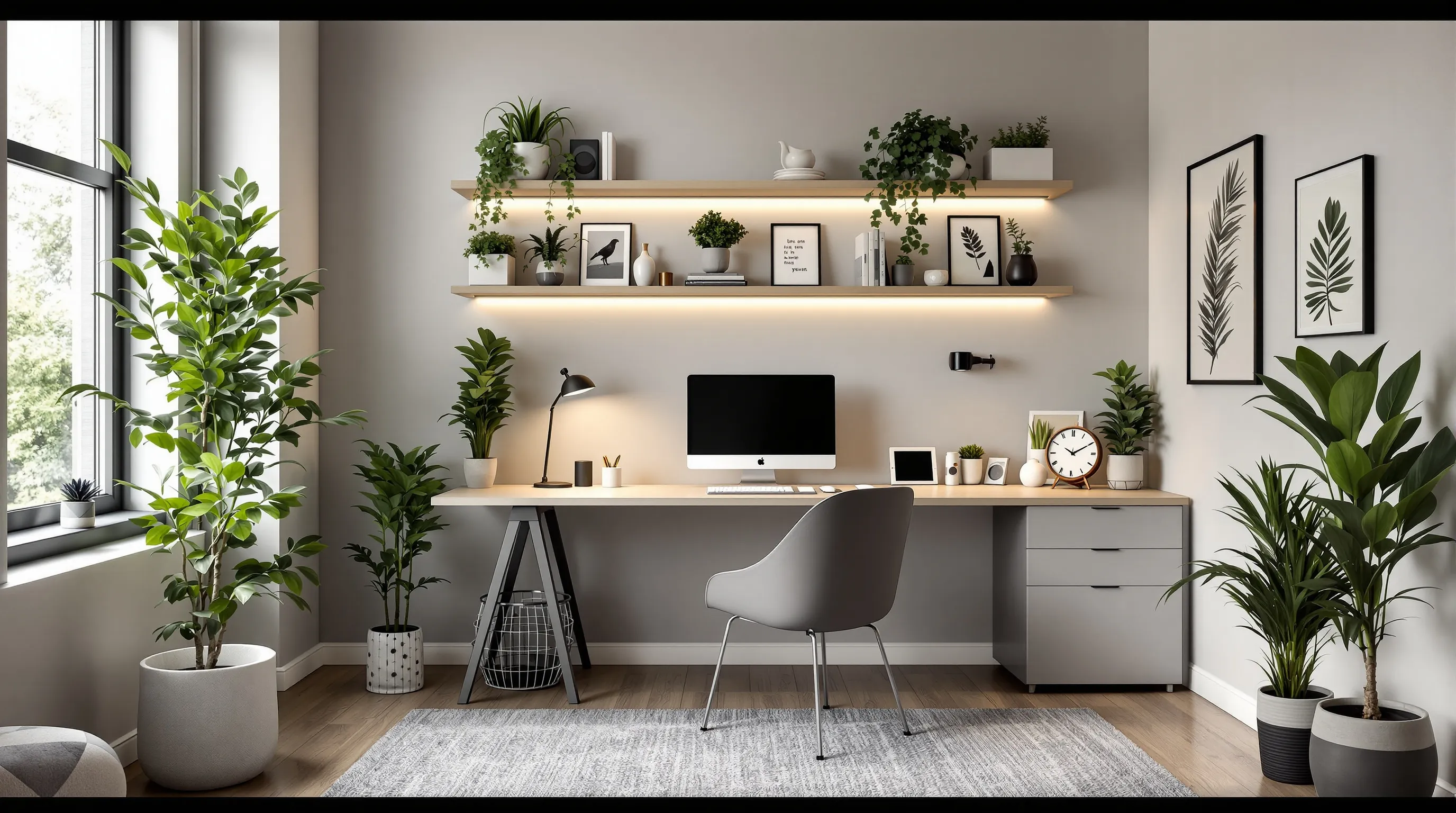
Small spaces demand creative thinking and strategic furniture choices to maximise productivity. Transform even the tiniest corners into efficient workspaces by implementing space-saving solutions that prioritise functionality without sacrificing style.
Converting Alcoves and Nooks
Alcoves and awkward spaces like loft areas or under-stairs corners offer untapped potential for creating productive workspaces. These compact zones provide natural boundaries that help separate work from living areas, making them ideal for focused tasks.
Built-in solutions maximise every inch. Custom-fitted furniture transforms narrow alcoves into efficient work zones. A U-shaped desk configuration fits perfectly into bedroom nooks whilst providing versatile functionality – doubling as a vanity area when work ends. Loft offices benefit from inherent quietness and ample storage opportunities, even though sloping ceilings requiring careful planning.
Extend depth for additional functionality. Carry worktops and shelving around corners to create extra storage for books and documents. This technique transforms cramped alcoves into spacious-feeling work areas. Under-stair spaces in light, airy living rooms make excellent office locations when equipped with appropriate desk, chair and shelving configurations.
Lighting and electrical considerations. Install adequate plug sockets for desk lamps and charging points during conversion planning. LED strip lighting integrated into shelving brightens alcoves whilst maintaining clean lines. Floor lamps save precious desk space whilst providing necessary task illumination.
Multi-Purpose Room Designs
Multi-purpose rooms accommodate modern living patterns where dedicated office space isn’t available. These flexible designs blend seamlessly with existing home décor whilst maintaining professional functionality.
Wall beds with integrated desks combine sleeping and working areas efficiently. Fold-down or flip-down desk systems maximise functionality in compact guest rooms. When work finishes, simply fold away the desk to restore the room’s primary purpose. This solution works particularly well for households needing overnight accommodation alongside workspace requirements.
Modular furniture systems adapt to changing daily needs. Console desks with built-in storage blend into living areas without disrupting family activities. Shelf and desk combinations provide display opportunities for personal items whilst maintaining work surfaces. These systems accommodate shared family spaces where multiple users require workspace access.
Strategic room dividers create visual separation without permanent structural changes. Tall bookcases or decorative screens partition work areas from relaxation zones. This approach maintains open-plan living benefits whilst providing necessary psychological boundaries between work and leisure activities.
Smart storage integration keeps multi-purpose rooms tidy. Folding tables disappear when laptop work concludes, leaving rooms available for alternative uses. Storage benches provide seating whilst hiding office supplies. Built-in cabinetry maximises unusual spaces whilst maintaining room aesthetics.
| Solution Type | Space Requirement | Key Benefits |
|---|---|---|
| Wall bed with desk | 2.5m x 2m minimum | Combines sleep/work functions |
| Fold-down desk | 1m x 0.6m when closed | Disappears completely when unused |
| Console desk with storage | 1.2m x 0.4m | Blends with living room furniture |
| Under-stairs office | 2m x 1.5m minimum | Utilises otherwise dead space |
Technology integration enhances multi-purpose functionality. Virtual assistants manage calendars and reminders whilst reducing desk clutter. USB-enabled shelving systems eliminate cable chaos. Smart lighting adjusts brightness throughout the day, supporting both work tasks and evening relaxation.
Display solutions add personality without compromising professionalism. Cabinets with integrated lighting showcase personal collections whilst protecting items from dust. Floating shelves display plants, artwork and meaningful objects that enhance workspace appeal without cluttering work surfaces.
Lighting Your Home Office Effectively

Effective lighting transforms your home office from a dim corner into an energised workspace that supports focus and reduces fatigue. Most home workers underestimate how dramatically poor lighting affects their productivity and wellbeing throughout the day.
Layering Different Light Sources
Combine three distinct lighting types to create optimal illumination. Task lighting provides focused light for your computer work and document reading. Ambient lighting fills the room with general illumination that prevents harsh shadows. Accent lighting highlights specific areas or features to add visual interest to your workspace.
Position ceiling fixtures to distribute even ambient light across the room. Add desk lamps or adjustable floor lamps to direct bright light onto your work surface. Include wall-mounted lights or LED strips behind your monitor to reduce eye strain from screen glare.
Match your light fixture materials and colours to your existing office décor. Brass fittings complement traditional styles whilst sleek metal designs suit modern minimalist spaces. Coordinate lampshades with your colour scheme to maintain visual harmony throughout the room.
Choosing LED Solutions for Energy Efficiency
LED lighting offers superior energy efficiency and produces minimal heat compared to traditional incandescent bulbs. LEDs consume 75% less energy and last 25 times longer than standard lighting options.
Install LED strip lights under your desk surface to eliminate shadows on your keyboard and paperwork. Mount LED tape behind your computer monitor to create gentle backlighting that reduces eye fatigue during extended screen time. Use LED spotlights in shelving units to illuminate reference materials and display items.
Choose adjustable LED fixtures that allow you to modify brightness levels throughout your working day. Dimmer switches let you increase illumination for detailed tasks or reduce intensity during video calls.
Positioning Lights to Avoid Glare
Position your primary light source at a 45-degree angle to your work surface to minimise shadows and reflections. Avoid placing bright lights directly behind or in front of your computer screen as this creates uncomfortable glare.
Place desk lamps to the side of your dominant hand to prevent casting shadows whilst writing or typing. If you’re right-handed, position the lamp on your left side and vice versa for left-handed users.
Use lampshades or diffusers to soften harsh light output. Opaque or frosted shades distribute light more evenly than clear glass fixtures. Adjustable lampshades let you direct light precisely where needed without creating bright spots or dark areas.
Utilising Natural Light Properly
Position your desk perpendicular to windows rather than directly facing them to maximise natural light benefits without screen glare. Natural light provides the full spectrum of illumination that artificial lights cannot replicate completely.
Install quality blinds or curtains to control excessive sunlight during peak hours. Adjustable venetian blinds allow you to redirect natural light upwards onto your ceiling for softer ambient illumination.
Add a mirror opposite your window to reflect natural light deeper into your office space. This technique doubles the apparent brightness without increasing your electricity consumption.
Creative Lighting Ideas for Visual Appeal
Consider floor lamps instead of traditional desk lighting to create a more residential feel in your workspace. Tall floor lamps with adjustable heads provide task lighting whilst maintaining a less clinical appearance.
Install coloured accent lights to enhance your office atmosphere. Soft blue or green LED strips create a calming environment whilst warm amber tones add cosiness during evening work sessions.
Use pendant lights or suspended fixtures to define your work zone in multi-purpose rooms. Hanging lights create visual boundaries between your office area and other room functions without requiring physical partitions.
| Lighting Type | Purpose | Best Position | Energy Usage |
|---|---|---|---|
| Task lighting | Focused work illumination | 45-degree angle to desk | 15-25 watts LED |
| Ambient lighting | General room illumination | Ceiling or wall-mounted | 40-60 watts LED |
| Accent lighting | Visual interest and atmosphere | Behind monitor or shelving | 5-15 watts LED |
| Natural light | Full spectrum illumination | Perpendicular to workspace | Zero energy cost |
Your lighting choices directly impact your comfort and productivity levels. Test different combinations and brightness settings to discover what works best for your specific tasks and working hours.
Creating Visual Interest with Décor
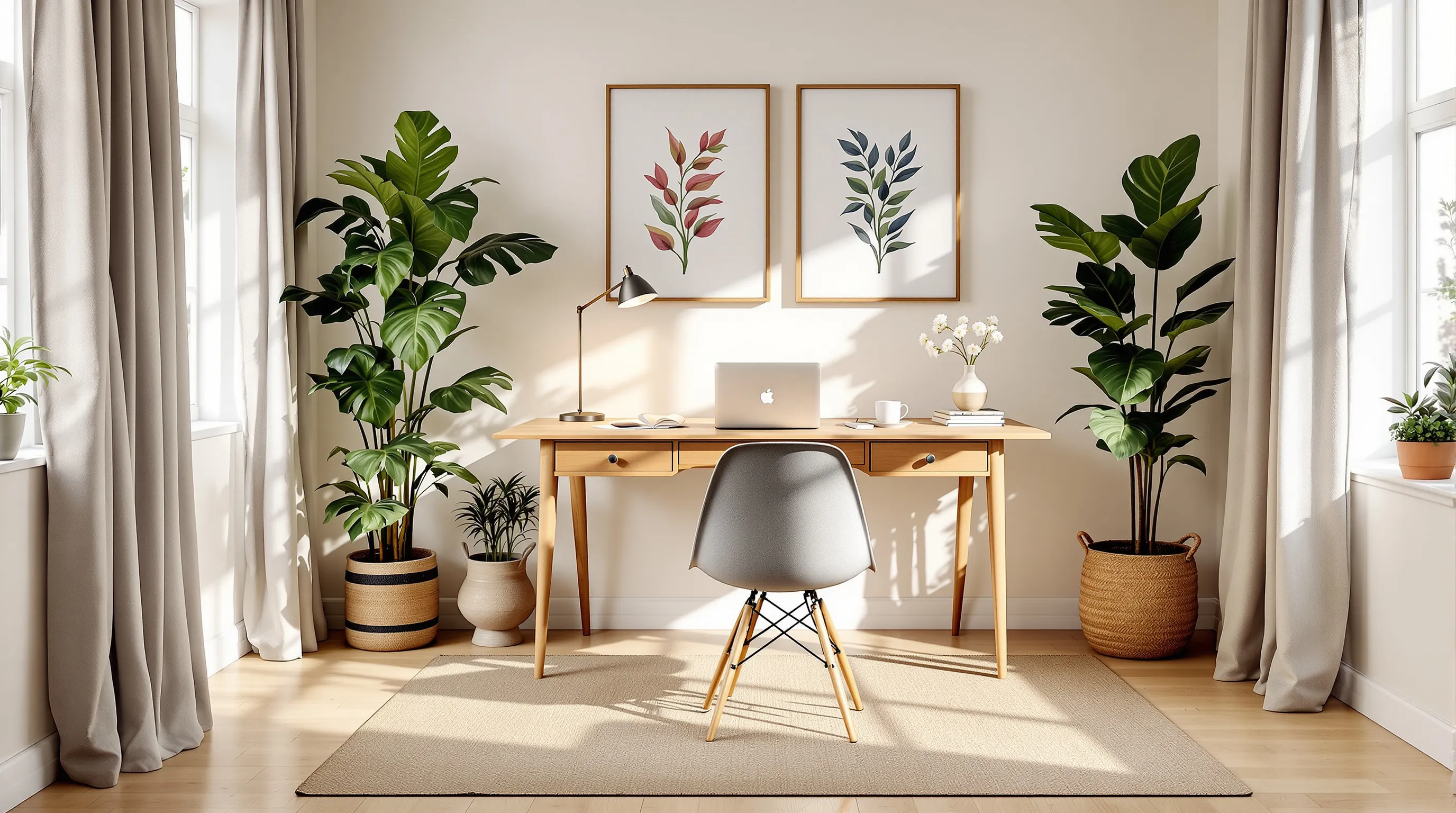
Transform your home office into an engaging workspace by incorporating decorative elements that boost both productivity and visual appeal. Strategic décor choices create personality whilst maintaining the professional atmosphere essential for focused work.
Wall Treatments and Art
Wall art instantly elevates your home office from bland to inspiring. Choose botanical prints or landscape photography to connect your workspace with nature’s calming influence. Position artwork at eye level when seated to create natural focal points during breaks from screen work.
Modern designer panels that mimic natural wood grains add texture and depth without overwhelming smaller spaces. These treatments work particularly well behind your desk area, creating a sophisticated backdrop for video calls. Consider removable wallpaper with subtle geometric patterns if you’re renting or prefer temporary solutions.
Create gallery walls using a mix of framed prints, small shelves, and inspiring quotes. This approach allows you to display personal achievements alongside motivational artwork. Frames in matching finishes – whether black metal or natural wood – maintain cohesion whilst adding visual weight to lightweight prints.
Wall-mounted pinboards serve dual purposes as both functional organisation tools and decorative features. Choose fabric-covered versions in colours that complement your overall scheme, or opt for cork boards framed in attractive mouldings for a more polished appearance.
Plants and Natural Elements
Plants boost well-being and productivity by bringing outdoor tranquillity indoors. Snake plants, ZZ plants, and spider plants thrive with minimal care if you lack gardening confidence. These hardy varieties tolerate low light conditions and infrequent watering whilst effectively purifying your workspace air.
Group plants of varying heights to create dynamic arrangements. Place a tall floor-standing plant in empty corners, position medium-sized plants on floating shelves, and add small succulents to your desk surface. This layered approach creates visual depth whilst maximising your greenery impact.
Preserved plants offer maintenance-free alternatives that provide natural beauty without watering responsibilities. High-quality artificial plants now closely replicate living varieties, particularly useful for windowless offices or frequent travellers.
Consider hanging planters to utilise vertical space effectively. Trailing plants like pothos or string of hearts create living curtains that soften harsh architectural lines whilst keeping floor areas clear for furniture and movement.
Large statement plants become instant focal points. A mature fiddle leaf fig or elegant monstera transforms plain corners into striking features that energise your workspace atmosphere.
Rugs and Textiles
Rugs define your workspace boundaries whilst adding warmth and comfort underfoot. Natural fibre options like jute or sisal introduce organic textures that complement plant displays and wooden furniture. These materials age gracefully and withstand the wear of rolling desk chairs.
Layer different textures through cushions, throws, and window treatments. A cushion on your desk chair increases comfort during long work sessions, whilst a soft throw draped over a reading chair creates an inviting spot for breaks or phone calls.
Choose textiles in organic materials such as cotton, linen, or wool to reinforce natural themes. These fabrics breathe well, maintain their appearance longer, and contribute to a healthier indoor environment compared to synthetic alternatives.
Consider the practical aspects of textile choices. Darker colours and patterned designs hide stains better than light solids, whilst machine-washable fabrics simplify maintenance. Position rugs to protect flooring from chair wheels whilst ensuring they’re large enough to accommodate desk and chair movement.
Window treatments in natural fibres soften harsh sunlight whilst maintaining privacy. Linen curtains or bamboo blinds filter daylight beautifully, creating gentle illumination that reduces screen glare during different times of day.
Practical Considerations
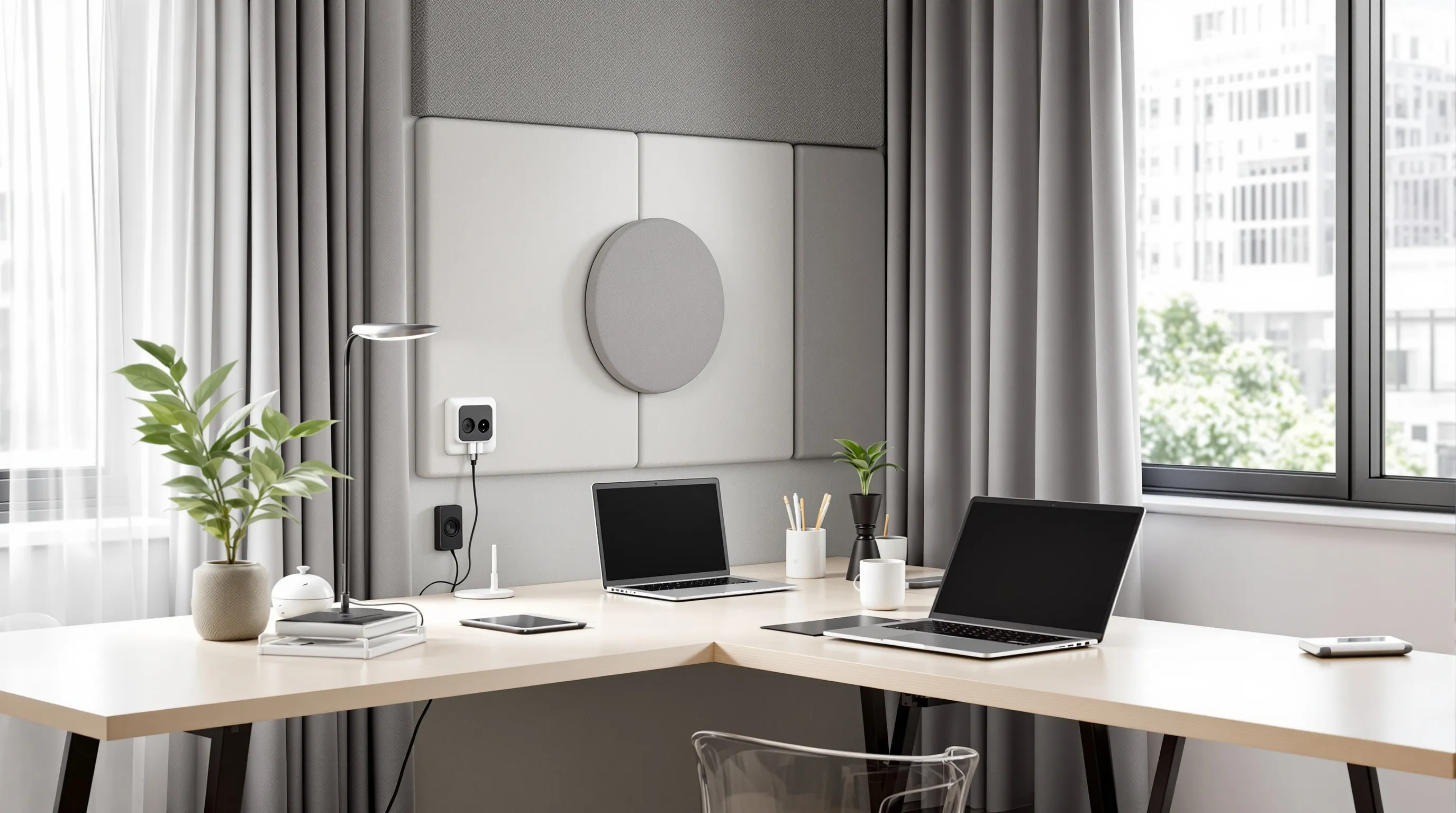
Practical considerations form the foundation of any successful home office design. These essential elements determine how effectively your workspace functions on a daily basis.
Cable Management and Technology
Cable management transforms chaotic workspaces into organised environments that promote focus and safety. Modern home offices require multiple devices – computers, monitors, printers, phones, and charging stations – each contributing to potential cable clutter that disrupts both aesthetics and functionality.
Smart organisation starts with identifying all technology requirements before furniture placement. Count your devices and their power needs to determine adequate socket placement. Position power strips under desks using mounting brackets to keep them accessible yet hidden from view.
Cable trays mounted beneath desk surfaces contain loose wires while maintaining easy access for adjustments. These shallow channels run along desk undersides, guiding cables from devices to power sources without creating floor hazards. Alternatively, cable management spines attach to desk legs, bundling multiple cables into single, neat columns.
Desk grommets provide clean entry points for cables passing through work surfaces. These circular openings, typically 60-80mm in diameter, accommodate multiple cables while maintaining professional appearances. Rubber-lined grommets prevent cable damage and reduce dust accumulation.
Technology integration extends beyond basic connectivity. Smart speakers assist with calls, reminders, and background music without occupying valuable desk space. Position these devices within 3-metre range for optimal voice recognition while avoiding interference with video calls.
Wireless solutions reduce cable requirements significantly. Bluetooth keyboards, mice, and headphones eliminate desk clutter while providing freedom of movement. But, maintain charging stations in designated areas to prevent device downtime during critical work periods.
Cable sleeves bundle groups of wires into single, manageable units. These fabric or plastic tubes expand to accommodate varying cable thicknesses while compressing to neat diameters. Use different colours to identify specific cable groups – power, data, or peripherals.
Consider integrated desk solutions featuring built-in cable management systems. These designs include hidden channels, pop-up power units, and dedicated equipment storage that maintains clean surfaces while providing full functionality.
Soundproofing and Privacy
Soundproofing creates focused work environments by controlling noise intrusion and preventing sound transmission. Effective acoustic treatment addresses both absorption and isolation to maintain concentration during calls and intensive work sessions.
Soft furnishings provide immediate acoustic improvements without major construction. Heavy curtains absorb sound reflections while creating visual barriers when hung from ceiling-mounted tracks. Choose fabrics with dense weaves – velvet, wool, or acoustic-specific materials – for maximum sound absorption.
Acoustic panels mounted on walls reduce echo and reverberation within office spaces. These fabric-wrapped foam or fibreglass panels come in various sizes and colours to complement existing décor. Position panels at ear level when seated, focusing on surfaces that reflect sound towards your working position.
Ceiling treatment proves particularly effective in rooms with hard surfaces. Acoustic tiles or suspended panels reduce sound bounce between floor and ceiling, creating calmer work environments. Modern acoustic solutions include decorative options that enhance rather than detract from room aesthetics.
Privacy screens create immediate separation in shared or multipurpose spaces. Moveable panels on wheels provide flexibility while offering sound absorption and visual barriers. Heights of 1.5-1.8 metres provide adequate screening while maintaining room openness.
Furniture placement contributes significantly to acoustic comfort. Position desks away from high-traffic areas and noise sources like kitchens or entertainment spaces. Create buffer zones using bookcases or storage units that double as sound barriers.
Door seals eliminate sound gaps around frames and thresholds. Self-adhesive strips or brush seals reduce noise transmission through these common weak points. For spaces requiring complete isolation, consider solid-core doors with proper sealing systems.
Floor treatment addresses impact noise and footfall sounds. Thick rugs or carpet reduce hard surface reflections while providing comfort underfoot. Choose natural fibres like wool for superior acoustic properties and durability in high-use areas.
White noise generation masks distracting sounds while maintaining privacy for confidential calls. Desktop fountains, fan units, or dedicated white noise machines create consistent background sound that covers intermittent disturbances without requiring high volumes.
Room dimensions influence acoustic behaviour significantly. Square rooms create standing waves and echo problems, while rectangular spaces with different wall lengths reduce these issues. If possible, position workstations at room thirds rather than centres to minimise acoustic problems.
Professional acoustic assessment identifies specific problem frequencies and recommends targeted solutions. This approach proves cost-effective for serious home office investments where acoustic comfort directly impacts productivity and professional image during video conferences.
Conclusion
Creating your perfect home office doesn’t have to overwhelm you or break your budget. With thoughtful planning and strategic design choices you can transform any space into a productive workspace that truly works for your lifestyle.
Remember that the best home office design balances functionality with personal style. Whether you’re drawn to minimalist aesthetics or prefer a more eclectic approach your workspace should inspire you daily whilst supporting your professional needs.
Start with one element—perhaps improving your lighting or reorganising your storage—and build from there. Small changes often yield the biggest improvements in how your space feels and functions.
Your home office is an investment in your productivity and wellbeing. Take time to create a space that energises you because when you love where you work you’ll naturally perform at your best.
Frequently Asked Questions
What are the essential furniture pieces needed for a home office?
The two most essential items are a desk and ergonomic seating. Your desk should be large enough to accommodate your work tools, with materials like glass, teak, or mahogany setting the design tone. A quality task chair is crucial for comfort during long working hours. Additional items like desk lighting, filing cabinets, and bookcases enhance functionality and organisation.
How much space do I need for a functional home office?
You don’t need much space for an effective home office. An area of 8×10 feet is adequate for a built-in desk and storage, whilst 10×13 feet allows for a floating desk with additional cabinetry. Even smaller nooks can work with smart furniture choices, vertical storage, and multi-functional pieces that maximise every square foot.
What colours should I choose for better productivity?
Muted blues and greens promote sustained concentration and focus. Soft neutrals provide a clean, distraction-free backdrop, whilst earthy tones like terracotta create warmth. Pale yellow can make small spaces feel larger and stimulate creativity. Test colours under different lighting conditions and consider balanced combinations for optimal productivity and mood enhancement.
How can I create a home office in a small room?
Utilise unused nooks, alcoves, or even fitted wardrobes as workspace areas. Consider folding tables for laptops that can be tucked away when not needed. Opt for multi-functional furniture like desks with built-in storage or storage benches. Vertical storage solutions and floating shelves maximise floor space whilst maintaining organisation.
What lighting is best for a home office?
Combine task, ambient, and accent lighting for optimal illumination. Position light sources to minimise glare and shadows on your workspace. LED lighting offers energy efficiency and longevity. Ensure adequate natural light without direct glare, and consider adjustable desk lamps for focused work. Good lighting reduces eye strain and enhances productivity throughout the day.
How do I manage cables and technology in my home office?
Use cable management solutions like cord organisers, cable trays, or desk grommets to keep wires tidy. Integrate technology thoughtfully with smart lighting and virtual assistants. Ensure reliable internet connectivity and adequate electrical outlets. Hide unsightly tech equipment behind cabinet doors or within designated storage areas to maintain a clean, professional appearance.
What storage solutions work best for home offices?
Maximise vertical space with wall-mounted shelves and tall bookcases. Use hidden storage within desks and multi-functional furniture. Filing systems keep important documents organised, whilst display cabinets can showcase personal items professionally. Built-in solutions often provide the most efficient use of available space whilst maintaining a cohesive design aesthetic.
How can I soundproof my home office for better focus?
Use soft furnishings like rugs, curtains, and upholstered furniture to absorb sound. Consider acoustic panels on walls for enhanced noise control. Strategic furniture placement can create natural sound barriers. Door seals and privacy screens help create a more secluded environment. Plants also contribute to sound absorption whilst adding visual appeal.
